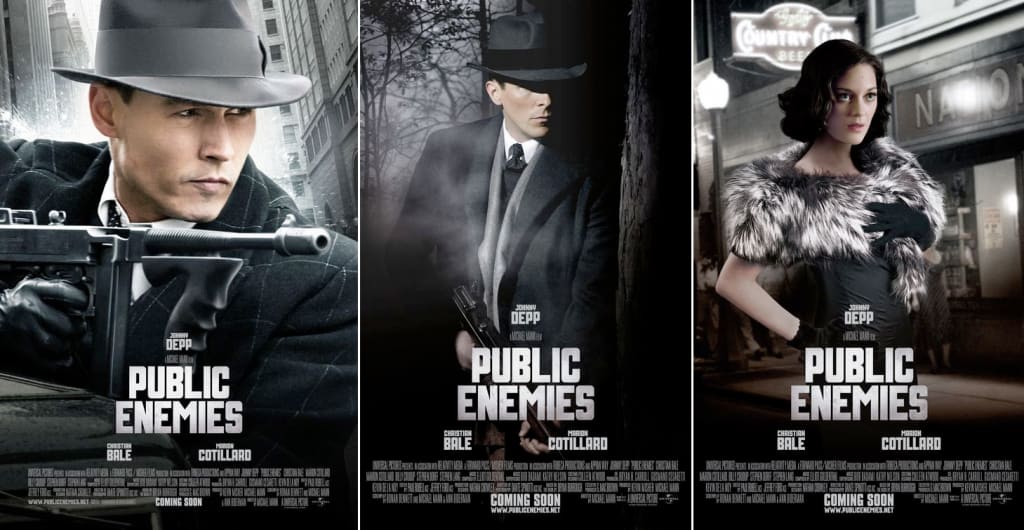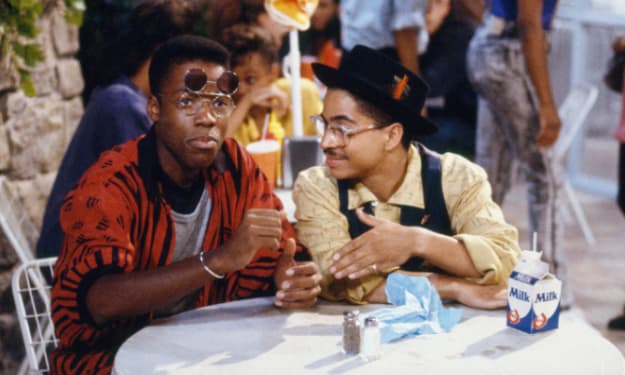A Filmmaker's Guide: Michael Mann's 'Public Enemies' (2009)
Filming Your Classic Crime/Drama

(Note: in order to get the most out of the article, it is recommended that you watch the film in question at least once all the way through. Notes are not required, but encouraged).
Public Enemies (2009) is a crime/drama film directed by Michael Mann, director of The Insider (1999) and The Last of the Mohicans (1992). Public Enemies is supposed to come off as your gritty, classic crime drama of early cinema without using outdated techniques but by using classic styles that are still constant in our own time.
The film itself is a brilliant example of what a crime/drama should be with lots of violence, tons of tension, and a mass of great characters and amazing acting. What we're going to look at is the two characters and how they work opposite each other. That's John Dillinger portrayed by Johnny Depp and Melvin Purvis portrayed by Christian Bale.
What we're concentrating on as a breakdown is:
- How the character is portrayed
- How this has an effect on the overall genre of the film
The point of portraying two characters in opposition like this would be to enhance the genre and the experience of that particular genre that is already in place. And with the crime/drama in mind, we're going to start our analysis.
Section 1: John Dillinger
John Dillinger, based on the real gangster, thief, criminal, etc. and portrayed by Johnny Depp, is filmed through the lens of wide shots to show his hold over other characters, medium shots to show him doing things and close-ups to show his expressions. How does this scene above utilise all of those? How do we initially create the character of John Dillinger in our minds and what is our first impression of him?
Notice how John Dillinger isn't the first character we see, instead it is someone working for him. This possibly tells us that he's a very important character, probably more important than we think he is. Also, the fact he's robbing a bank—if you don't know who John Dillinger is—lets you know that he's a criminal. The way he's dressed and the way he's being filmed lets us know that he is the main/primary character we need to focus on in this particular scene.
In terms of filming your own crime/drama, you need to make sure that you have established each aspect you want the audience to understand of the character by the first few scenes. Again, we have the three main shots that are used throughout the movie to show John Dillinger's nature and so, we make these shots relative to him. We use them in the first scene to show what we are going to have them show later on and parallel to create a character profile of Dillinger through cinematography.
Wide Shot = Dillinger as a master over others
Medium Shot = Dillinger carrying out the act
Close-Up Shot = Dillinger's expressions and personality
Now apply what we've just established to this scene from the film:
There's something incredibly repetitive about the way certain characters are filmed, but in order to stop the question of John Dillinger's hold over others, his actions and his feelings—we tweak the cinematography instead of the dialogue. Notice that throughout the film, Dillinger tends to avoid his emotions mostly. But, instead we have these moments of close-up and extreme close-up in which we can see his expression, no matter how static it is. It tells us more than dialogue can. If you're filming a crime/drama, the last thing you want is it to be all matter-of-fact dialogue—use your actor's facial expressions well.
The way in which this character is created is pretty simple since yes, he's the main character. But let's have a look at his opposition, Melvin Purvis portrayed by Christian Bale. Let's have a look at what is similar in filming style and what is different. Most importantly though is to look at the impact of these similarities and differences upon the overall crime/drama.
Section 2: Melvin Purvis
Notice one of the first things we see of Melvin Purvis in the clip above is the back of him. This is very important to ensure that we know he's a cop. We get to see exactly what he's wearing and now we know why. It's smarter than saying that he's a cop and, the audience will pick this cue up immediately. Close-Up and Extreme Close-Up seem to be huge fans of Christian Bale as his facial expressions are the main fixtures of the scene. This is very important because this is the man that is trying and failing to catch John Dillinger, one of America's greatest criminals. We need to know how he's feeling because in all aspects, we're on his side. The more we see of his face the more we can identify with the 'good' character. As opposed to the relaxed atmosphere we have when we see some of the scenes with Dillinger, we have the complete opposite when it comes to Purvis. In this scene he's running around and running down the stairs and everything is very tense. This opposition shows us the side we should be identifying with without telling us directly. It is far more effective this way.
Now, apply the same logic to this scene:
Notice how we see Melvin Purvis still moving very quickly, still very tense even though by this point, he's winning. We still get to see his extreme facial expressions and yet, we still understand that the movie is beginning to come to a close and Dillinger is going to die at Purvis's hand. The shots are still the same, but as we begin to come to the close of the film, we get more shots of Purvis instead of Dillinger. The film gives this audience this type of shift and so, this is how we begin to understand the closing of the film.
As this becomes more and more realised through the ending, we get more and more of a shift towards shots of Purvis instead of Dillinger until Dillinger entirely disappears. It's an efficient way of presenting the close to your crime/drama because of the fact you don't really need to tell anyone that this is the closing of the film. The 'turn' or the 'volta' from one character to another presents this for you.
Conclusion:
A brilliant film that you can learn a lot from, this is possibly one of Michael Mann's best achievements since Last of the Mohicans (1992). You can analyse each of the separate scenes and see exactly how each one shows aspects of character as character is the main focal point of the entire film. Character and opposition are the focal points and that is the one thing you should remember when making your own crime/drama. As long as you've established and patterned those two then you can do whatever the hell you want with the rest. Good luck on your next project.
About the Creator
Annie Kapur
200K+ Reads on Vocal.
English Lecturer
🎓Literature & Writing (B.A)
🎓Film & Writing (M.A)
🎓Secondary English Education (PgDipEd) (QTS)
📍Birmingham, UK






Comments
There are no comments for this story
Be the first to respond and start the conversation.